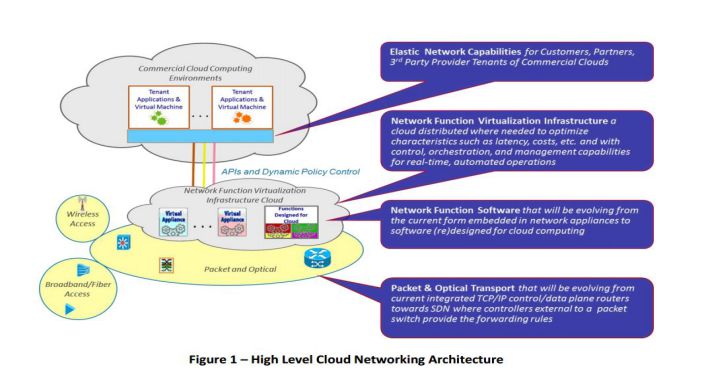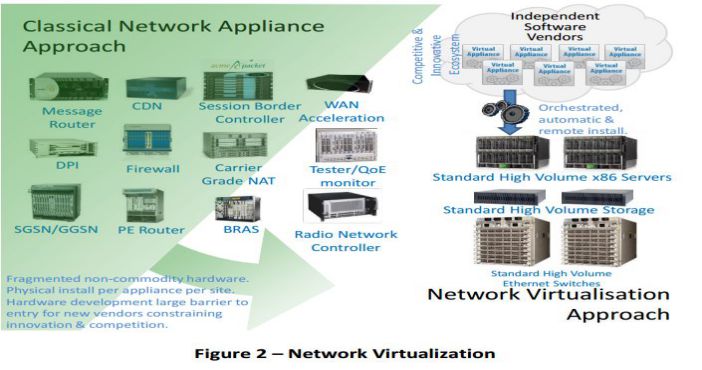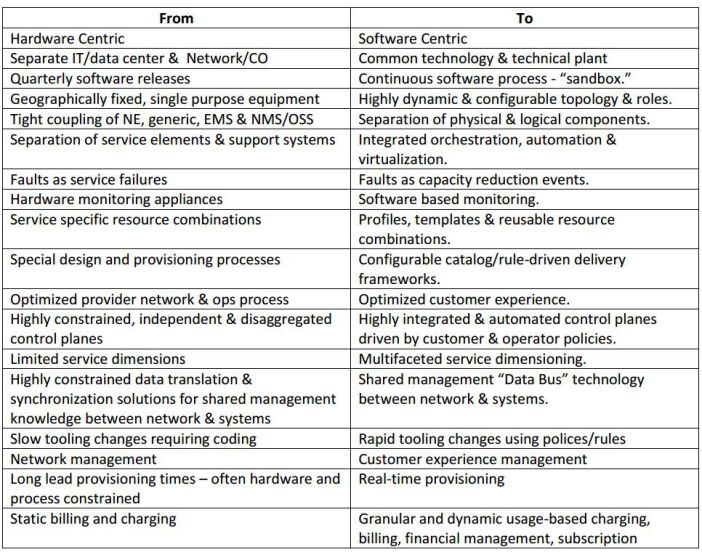What is Domain 2.0?
Domain 2.0 is an initiative from AT&T to transform its network and infrastructure into a system that resembles cloud computing services. In order to do so, AT&T plans to replace some of its current network elements with those that can be directed with software using network functions virtualization infrastructure and have those software-based components perform a broad variety of tasks using software-defined networking protocols.
AT&T’s services will become increasingly software-based, from its data centers to its network edges. A system of orchestrated software is expected to be able to perform a number of similar tasks at greater scale and reliability using cloud architecture. This is designed to make for a more dynamic system as instead of using an edge router with a pre-integrated set of functions, Domain 2.0 can produce a router with NFV software modules, silicon and controllers. Software will then be written to manages fewer resources, and puts all routers, switches, edge caches and middle boxes into one resource pool.
Why is AT&T moving to this system?
AT&T cites an increasing number of IP endpoints as a reason for shifting to a new system that has greater scale and efficiency in handling the number and diversity of devices in its network.
“We announced Domain 2.0, also known as our software-defined network strategy, two years ago because network traffic trends were outpacing the ability to keep up with the traditional, hardware-centric network model,” said Andre Fuetsch, SVP of Domain 2.0 Architecture & Design at AT&T. “Data traffic on our wireless network grew more than 150,000% between 2007 and 2015, and today 60% of our total network traffic is video. New applications like the ‘internet of things,’ 4K video, and virtual and augmented reality are expected to push that demand even higher in the years ahead.”
The telecom giant also has increasing competition from the likes of Google, which already has a robust cloud network, and now partners with T-Mobile US and Sprint for its own Project Fi mobile service.
“The cloud providers are yanking us, despite ourselves, into this future — they’re the ones that are driving this growth,” said Toby Ford, AT&T’s area VP for cloud technology strategy, in an address at NFV World Congress 2015. “I would argue that they’re very similar to us when you strip away the function.”
With a cloud-based network, AT&T believes it will be able to simplify and scale its operations in order to retain its place in the wireless market.
What does Domain 2.0 do for AT&T and its customers?
AT&T gives three overarching outcomes of moving to a Domain 2.0 environment.
Open – Provide APIs, enable better participation of third parties, and improve visibility. Increase the number of suppliers and partners AT&T can do business with.
Simplify – Weed out complexity from services and operations; support more nimble business models.
Scale – Meet evolving customer requirements including traffic growth, diversity of traffic types, and diversity of performance and reliability expectations. Improve business efficiency in capital and operations.
The main benefit of Domain 2.0, according to AT&T, is the ability for the company to share a pool of resources and capital expense with its customers and “use those resources to compose network capabilities and services on-demand.”
On the business side of things, AT&T believes the initiative will give greater access to technologies and innovations from data centers including rapid innovation in server hardware, virtualization, cloud computing, SDN switches and controls, independent software and software solutions and open-sourced communities. Additionally, the company will be hoping for a faster time to market for new products and services, more component and supplies choices, better utilization of physical resources and greater business model flexibility.
What needs to happen for AT&T to bring 1.0 to 2.0
Domain 2.0, in its early form, was a set of directions for the route AT&T is to take in virtualizing its network. To do so, it requires “a supplier and software ecosystem, appropriate business practices, a software-savvy planning and operations organization and management willing to try alternatives and fail fast,” according to AT&T’s Domain 2.0 white paper. And those requirements will come together to create an architecture that can support the company’s initiative, something it calls “cloud networking.”

This figure shows the elements of AT&T’s Domain 2.0 cloud networking vision. The elements in the yellow sections of the figure are current pieces of AT&T’s network set to be transitioned to common infrastructure and NFV.
“For many parts of these networks SDN techniques have the potential to add value and improve capability over the current way IP routers and optical transports are managed,” AT&T wrote in its Domain 2.0 white paper. “High level SDN controller languages promise to simplify configuration, ease the introduction of nimble policy control, provide greater capabilities, reduce errors and enable more real-time changes in a packet/optical network.”
The grey NFV cloud shows the new elements to be used to support NFV, where cloud operations, applications and architectures come together to support network workloads. And the final grey cloud, commercial cloud computing environments shows off the capabilities and flexibility of software controlled networks.
NFVI
What Domain 2.0 comes down to is AT&T’s realization that a software-based network offers more flexibility at a lower cost than its current proprietary hardware-reliant system. The multinational telecommunications company currently runs its network using large and constantly changing components that require the rare skill of designing and installing these systems – many of which end up having a short shelf life.
The initiative addresses these issues by using network functions to consolidate equipment types onto high volume servers, switches and storage located in data centers, network points of presence or customer premises. AT&T gives a list of benefits from switching from a proprietary hardware to a dynamic software approach.
- Reduced equipment diversity and reduced power consumption through consolidating equipment and exploiting the economies of scale of the IT industry.
- Architecturally decoupling the network function, based in software, from the support infrastructure, based in hardware. This can provide independent scaling and innovation among both.
- Increased speed of time-to-market by minimizing the typical network operator cycle of innovation. Economies of scale required to cover investments in hardware-based functionalities are strongly mitigated through software-based deployment, making other modes of feature evolution feasible.
- Availability of network appliance multiversion and multitenancy, which allows use of a single platform for different applications, users and tenants. This allows network operators to share resources across services and across different customer bases.
- Targeted service introduction based on geography or customer sets is possible. Services can be rapidly scaled up/down as required.
- Enable new types of network services. NFV can readily be applied to the control and management plane in addition to the data plane. This allows virtual networks to be created and managed by end users and third-parties using the tools and capabilities heretofore reserved only for native network operators.

SDN
SDN is an architecture for creating programmable, application aware and open networks. A number of companies use SDN, including Google and Amazon.com, to better respond to business needs and increase application deployment. It’s benefits, according to AT&T include:
- Creating multiple, virtual network control planes on common hardware. SDN can help extend service virtualization and software control into many existing network elements.
- Enabling applications to request and manipulate services provided by the network and allow the network to expose network state back to the applications.
- Exposing network capabilities through APIs.
- Making the control of network equipment remotely accessible and modifiable via third-party software clients, using open protocols such as OpenFlow, PCEP or even BGP-FlowSpec5.
- Logically decoupling network intelligence into differentiated software-based controllers, as opposed to integrated routers and switches. Often this flexibility allows a more centralized layer of control with a more global network view and that has some benefits in terms of improving control plane algorithms.
A guide from the past to the future of AT&T’s network

User-Defined Network Cloud
AT&T created a number of partnerships with companies of a range of sizes to help it gain software control of its telecom network. In 2014, it launched its User-Defined Network Cloud as part of Domain 2.0, with the hopes of significantly decreasing the pivot time to a virtualized architecture, and increase time-to-market of products and services. The initial set of companies announced to be working with AT&T to help virtualize its network included Ericsson, Tail-F Systems AB and Metaswitch Networks. The list of partners has expanded over the past few years and now includes Amdocs, Juniper Network and Nokia.
Where Domain 2.0 stands, and where it will end up
Domain 2.0 is still a set of directions continually being implemented by AT&T for its upcoming network enhancements. But the concept is already said to be off to a strong start of being realized, eclipsing its 2015 transition goals.
“The technology we’re using in our Domain 2.0 transformation is complex, but the concept is simple and familiar to any smartphone user,” Fuetsch told RCR Wireless News. “It’s like moving from devices to apps. We plan to virtualize 75% of our network by 2020. We lay the foundation in 2015 by hitting 5.7%, and we’re accelerating to 30% by end of 2016. This is a fundamental shift for us. While some companies are still struggling to define their software-centric strategy, we’re already delivering results for our customers.”
The returns of this new infrastructure and its projected future benefits have already had a direct impact on AT&T customers.
“We recently brought back unlimited data,” said Fuetsch in a blog post. “One of the reasons we were comfortable doing that is we know this software-centric network can adapt to meet the demand.”

